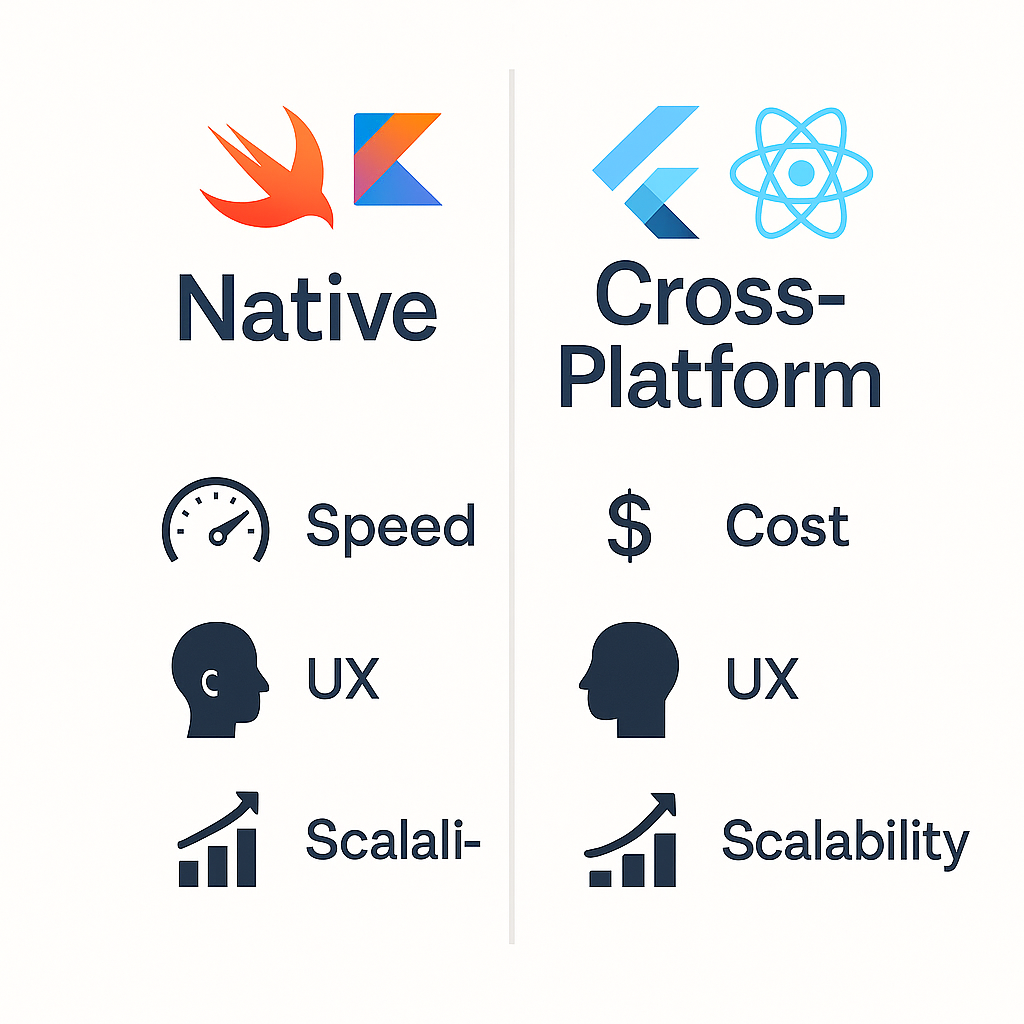When starting a mobile app project, one of the biggest strategic decisions is:
Should you build natively for each platform (iOS and Android), or go with a cross-platform approach that targets both with a single codebase?
This isn’t just a technical choice it impacts budget, time to market, user experience, and long-term scalability.
As a mobile developer with over a decade of experience building applications, I’ve seen this decision play out many times. In this article, I’ll break down the differences, use cases, and why many startups and even large companies are leaning toward cross-platform solutions today.
What is Native Mobile Development?
Native development means building separate apps for each platform using the official tools and programming languages:
- iOS: Swift (or Objective-C) with Xcode
- Android: Kotlin (or Java) with Android Studio
These apps are written directly for the platform they’ll run on, using the same language and framework that Apple or Google uses internally.
Benefits of Native Development:
- Maximum performance: Apps run faster and feel smoother, especially for demanding tasks like animations, camera usage, or background processing.
- Best possible user experience: Native apps follow platform-specific design guidelines (Material Design for Android, Human Interface Guidelines for iOS), leading to intuitive, fluid interfaces.
- Full access to hardware and OS APIs: Things like Bluetooth, ARKit, sensors, biometrics, push notifications, and background tasks are easier and more reliable natively.
- Long-term scalability: Native apps are often more maintainable in large projects when built with a mature architecture.
Downsides of Native:
- Double the work: You’ll need separate codebases for iOS and Android meaning more developers or more development time.
- Higher cost: More time, more developers, and more testing means a bigger budget.
- Slower MVP delivery: If speed to market is a priority, native can be a bottleneck.
What is Cross-Platform Mobile Development?
Cross-platform development allows you to write your app’s code once and deploy it to both iOS and Android.
Popular frameworks include:
- React Native (JavaScript/TypeScript)
- Flutter (Dart)
- Xamarin (.NET/C#)
- Ionic / Capacitor (HTML/CSS/JavaScript with web views)
These frameworks use a shared core, and often compile to native code (or close to it), allowing for a near-native experience with less duplicated effort.
Why Do So Many Companies Prefer Cross-Platform Today?
1. Cost Efficiency
This is the biggest driver. With cross-platform:
- You hire one development team instead of two
- You build one codebase instead of two
- You test once, and fix bugs once (most of the time)
For startups or businesses with limited resources, this can reduce development costs by 30–50% or more.
2. Faster Time to Market
With only one team working on a shared codebase, it’s possible to:
- Release a Minimum Viable Product (MVP) faster
- Iterate quickly based on user feedback
- Launch simultaneously on iOS and Android
This is especially important for startups trying to validate ideas before investing heavily.
3. Unified Updates and Maintenance
Any feature or fix added to a cross-platform codebase automatically benefits both platforms. This simplifies:
- Feature rollouts
- Regression testing
- Long-term code management
It’s easier to maintain one product roadmap than two parallel ones.
4. Talent Pool and Team Structure
Cross-platform frameworks like React Native and Flutter use popular languages (JavaScript, Dart), which are more accessible to many developers. It’s easier to build and scale teams using generalist developers, instead of hiring dedicated iOS and Android specialists.
So Why Is Native Still Used?
Despite its advantages, cross-platform isn’t always the right answer.
There are cases where native development still wins:
Performance-Critical Applications
If you’re building a game, a video editing tool, or an app that relies on intensive real-time operations (like AR, VR, or live data streaming), native will offer the performance edge you need.
📱 Polished UI/UX Requirements
Some apps require highly polished animations, gestures, and UI behaviors that feel 100% native. It’s possible to achieve this with cross-platform frameworks, but it often requires extra work sometimes more than just building it natively.
🔌 Deep Hardware or OS Integration
Apps needing deep integration with device capabilities such as health sensors, background services, or OS-level permissions are more stable and feature-rich when built natively.
Comparison Table: Native vs. Cross-Platform
| Feature | Native | Cross-Platform |
|---|---|---|
| Performance | ⭐⭐⭐⭐ | ⭐⭐ or ⭐⭐⭐ (Flutter) |
| Development Speed | ⭐⭐ | ⭐⭐⭐⭐ |
| Cost | €€€ | €€ |
| User Experience | ⭐⭐⭐⭐ | ⭐⭐ or ⭐⭐⭐ |
| Access to Device APIs | Full | Partial (can be extended) |
| Code Reuse | Low | High |
| Maintenance | More complex | Easier (one codebase) |
| Community & Plugins | Mature | Rapidly growing |
When Should You Choose Cross-Platform?
Go cross-platform if:
- You’re launching an MVP and need to validate fast
- You have a limited budget or small team
- Your app’s features are mostly standard (forms, API calls, navigation, media)
- You want to reach both iOS and Android users from day one
When Should You Go Native?
Go native if:
- Performance is a top priority
- You need advanced UI/UX control
- You’re building a platform-specific or device-dependent product
- You’re building for a single platform only (e.g., iOS-only)
Conclusion
There’s no universal answer only trade-offs based on your goals, timeline, and budget.
Many companies start with cross-platform for the MVP, then switch to native once they validate their product and scale. Others stick with cross-platform long-term if it meets their needs.
At the end of the day, the best choice is the one that aligns with your users, your team, and your business strategy.
If you’re not sure what’s right for your project, feel free to reach out I’d be happy to help evaluate the best path forward.

